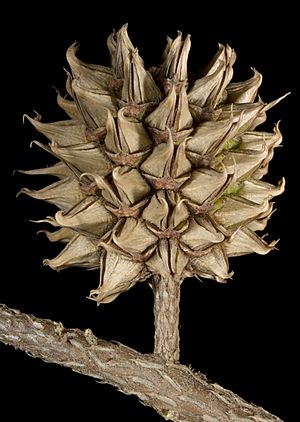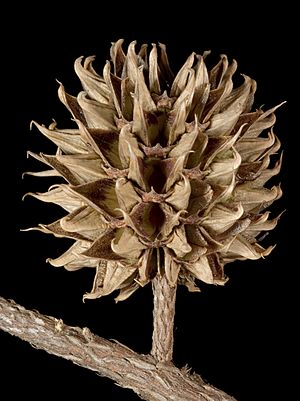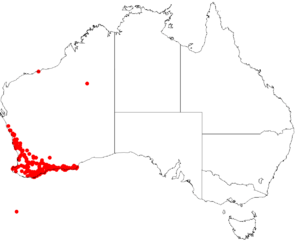Horned sheoak facts for kids
Quick facts for kids Horned sheoak |
|
|---|---|
 |
|
 |
|
| Scientific classification | |
| Genus: |
Allocasuarina
|
| Species: |
thuyoides
|
 |
|
| Occurrence data from AVH | |
The Allocasuarina thuyoides, often called the horned sheoak, is a type of shrub. It belongs to the Allocasuarina plant family. This plant naturally grows across a large part of Western Australia. You can find it in regions like the Mid West, Wheatbelt, South West, and Goldfields-Esperance.
This shrub usually grows to be about 0.3 to 2 meters (1 to 7 feet) tall. It can have both male and female flowers on the same plant, or sometimes separate male and female plants. The horned sheoak flowers for most of the year, from January all the way to December. After flowering, it produces special cones that have long, spiky parts. You can typically find A. thuyoides growing in areas like heathland, sandy plains, and the lower parts of hills. It prefers to grow in clay or sandy soils that contain laterite.
Contents
About the Horned Sheoak
The horned sheoak is a unique plant with interesting features. Its name, "horned sheoak," comes from the spiky cones it produces. These cones look a bit like small horns.
Where it Grows
This plant is native to Western Australia. It thrives in different types of landscapes, including:
- Heathland: Areas with low-growing shrubs and open spaces.
- Sandplains: Flat, sandy areas.
- Foothills: The lower parts of mountains or hills.
It's quite adaptable and can grow in various soil types, especially those that are clay-based or sandy with laterite. Laterite is a type of soil that is rich in iron and aluminum.
Life Cycle and Appearance
The horned sheoak is a shrub, which means it's a woody plant smaller than a tree. It can grow up to 2 meters (about 7 feet) tall. Its long flowering period, from January to December, means you can often see its flowers and developing cones throughout the year. The cones are a key feature, making it easy to identify this plant.
Taxonomy: How it Got its Name
The scientific name of a plant helps scientists around the world know exactly which plant they are talking about. The horned sheoak has had a couple of different names over time.
Original Discovery
It was first described in 1845 by a scientist named Friedrich Anton Wilhelm Miquel. He gave it the name Casuarina thuyoides.
Changing its Genus
Later, in 1982, another scientist named L.A.S.Johnson decided that this plant was different enough to be placed in a new group, or genus. So, he moved it from the Casuarina genus to a new one he created called Allocasuarina. That's why its full scientific name today is Allocasuarina thuyoides.

